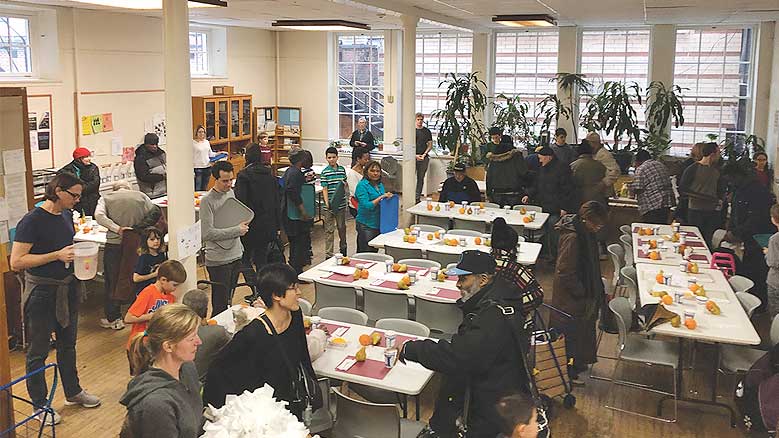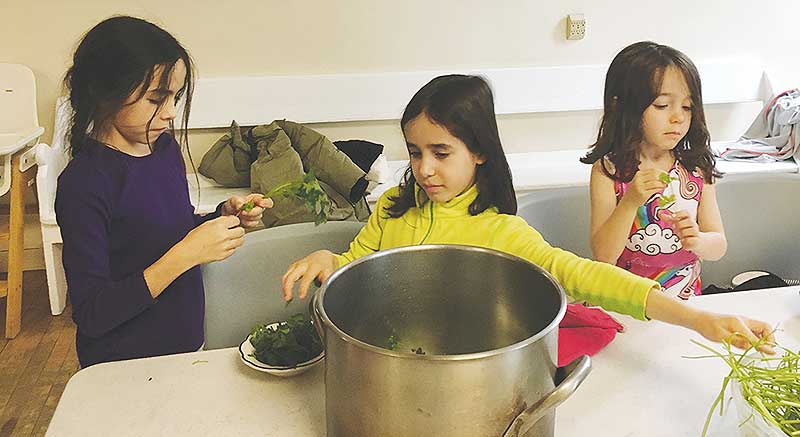
In 1987, Christine Koster, Heloise Rathbone, Christine Poff, and other Brooklyn Friends experienced a leading to start a soup kitchen or community dinner. A teenager at the time, Christine Koster recalls how it began:
Homelessness was a concern felt by many then, and the neighborhood around the meetinghouse was struggling. With the experience Christine Poff and I had with the [Quaker] Youth Service Opportunities Project (YSOP), we felt we could come up with a model that worked for us.
I remember presenting the proposal at business meeting. I don’t think I had ever been to a business meeting before, so it was quite intimidating. But the meeting was supportive. Doing it monthly seemed like something that was feasible.
We put flyers around and hoped for the best. If I remember correctly, there were over 100 people at our first dinner! It was kind of overwhelming. I coordinated volunteers [from the meeting] and helped at the dinners. Friends were eager to step up. We did not have other community groups involved at the beginning. Our attendance leveled at about 80 to 90.
Tom Rothschild helped out with the dinner from 1997 to 2017.
When I became involved in the late ’90s, we had two sittings and people got tickets. At that time, there were several family shelters in our area, and we posted information about the dinner in the shelters. If I remember correctly, we typically had 150 to 175 guests, often including families with young children.
All the diners now are single adults. The budgets of Ministry and Counsel and the Community Dinner Committees are the meeting’s largest. If Ministry and Counsel nourishes our corporate body and soul, the dinner committee feeds those in need who don’t normally cross our threshold.
The committee has nine members who organize and run the dinner. Five to ten other volunteers cook, and 25 serve up to 100 guests; lately, 70 is the average. (At social hour after worship on First Days, the meeting offers a light repast to about 60 attenders. Brooklyn Friends are foodies to a fault.)
Preparations include: inventory of food and supplies; shopping at a wholesale grocery and delivering the food; recruitment, scheduling, and coordination of volunteers the day of the event; posting flyers in the neighborhood; soliciting and picking up donations of produce, baked goods, and second-hand clothes from local stores and members of the meeting—all for distribution to our guests.
Who are our guests and where do they come from? Amidst downtown Brooklyn’s luxury housing rising like steeples in “the city of churches,” one might never know homeless shelters, halfway houses, and low-income housing still exist—subsidized by the city government and nonprofits. Most of our guests reside in these places. Some live on the streets or double up with family and friends.
Our hungry diners reflect the makeup of Brooklyn: young and old, multi-racial, different nationalities, a mix of sexes and genders. They are a determined lot. Some come with canes or walkers and a few on crutches or in wheelchairs. Even if they arrive unassisted, they show interest in each other’s welfare—culinary pilgrims to Brooklyn Meeting, their mini Lourdes.
They like hearty dishes, such as beef chili and barbecue chicken. For the holidays, we offer baked turkey and ham and pies donated by meeting members and attenders. Our guests also relish fresh salad, rice with beans, and Italian bread with butter. For dessert there’s pie, cake, brownies, cookies, and fruit (including watermelon in the summer). Scott Steib supervises the kitchen volunteers who provide this bounty.
One extra meal a month may seem like a pinch of salt in a pot of chicken soup. Abby Hanlon, co-clerk of the dinner committee, says it still makes a difference: “Our dinner is one small action in a city where one in eight residents are food insecure.” From the beginning, the community dinner event has always been on the last Sunday of the month because that’s when the food stamps, assistance, and checks run out, and the need is greatest.
Abby shares about involvement from the meeting’s younger generation: “Once last year my son, Burke, and I posted flyers in nearby shelters, parks, and the subway. That Sunday the dinner was packed, including many new faces. The experience has shaped his service to others.”

Like their annual fall pancake breakfast and summer picnic in our woodsy cemetery, the community dinner is an intergenerational Quaker affair.
Our First-day school students are regulars on the volunteer circuit. Like their annual fall pancake breakfast and summer picnic in our woodsy cemetery, the community dinner is an intergenerational Quaker affair. Brooklyn Friends School, a Seventh-day Adventist youth program, Compass Charter School, the Workmen’s Circle, Public School 118, Berkeley Carroll School, Open Heart Community Project, and the Girl and Boy Scouts are among the groups who help each year.
On community dinner days, the social room buzzes with so much activity, it looks like a movie set where cooks, servers, and diners all get top billing.
According to one guest, Charles, “Quakers are nice people. The kids are really respectful. I know a lot of people here. There’s a community feeling. The dinner helps me stretch my food stamps.”
Kincaid seconds Charles’s opinion: “I’ve been coming here for five or six years. I’m a building super, but they don’t pay me much. The dinner helps.” Dennis is also a regular: “Eight years. The food and the service are great.”
Jae seems to have more on her mind than just food. At every dinner she passes out religious tracts while people eat. Her message seems to be: You can’t feed the body properly without feeding the soul.
Our volunteers would agree. Parents and children set tables, spread butter on bread, wrap Oreos in paper napkins, arrange surplus vegetables, and fill pitchers with water, juice, and coffee. Just before serving the meal we all gather in a circle for silent grace.
The kitchen crew—otherwise quiet Quakers—is a noisy lot: “Don’t burn the chicken.” “More herbs and spices for the rice.” “How’s the salad dressing coming?” “Who’s on pots and pans?” “Do we have enough take-out containers?” Every community dinner runs like a well- (olive-)oiled machine.
The best part is when the kids serve our guests. While the adults encourage them from the wings, they put their best feet forward—wizzes at keeping orders in their heads and chit-chatting with regulars and newcomers. During cleanup, they have the equally daunting task of separating garbage from recyclable materials and compostable food waste.
One First Day it’s Berkeley Carroll School’s turn. Silas, a father of two children, says, “We’re handing out fruit, placing cups on the tables, and breaking down cardboard boxes. I coach soccer, but we’ve never done anything like this as a school.”
Isaac agrees: “I like helping people who don’t have enough to eat.” Lisa, his mom, chimes in, “We brought pantry goods and made a pie.”
Simone is another mother urging her kids on: “Vassia and George are setting up the tables. We were looking for a way as a family to help the community—to give time and effort, not just money.”
Ted Bongiovanni, a committee member who often supervises “the front of the house,” sums up the results: “The desserts, which included homemade cake pops and pumpkin pie, were amazing. Guests loved the chili menu and how it was prepared. There was a ton of [free] clothes for guests to choose from. But we were short committee members.” Will wonders never cease?



Comments on Friendsjournal.org may be used in the Forum of the print magazine and may be edited for length and clarity.